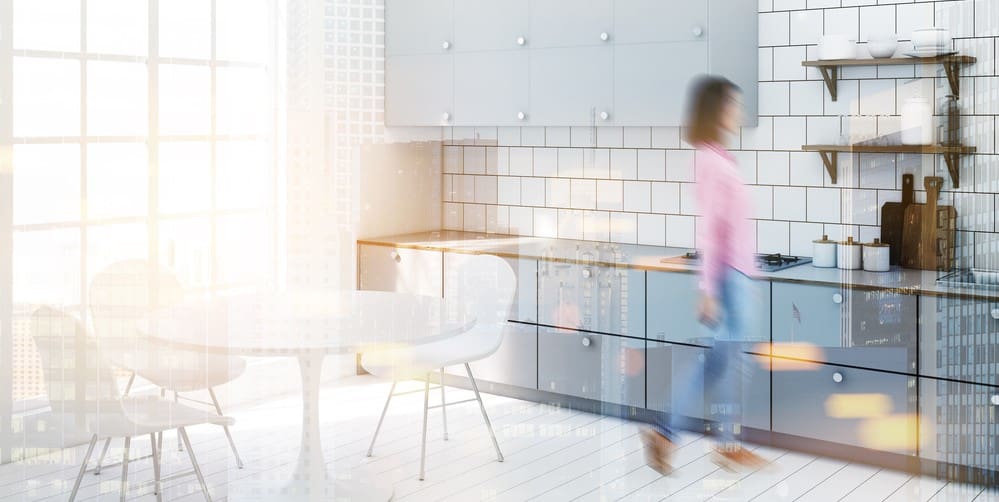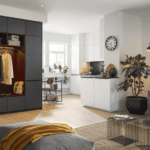Surviving a Kitchen Renovation – Part 2
Assessing the Kitchen You Have
It is a wise person who sits down and takes stock of what they have before they change it. This applies to many things, including kitchen remodelling. You should never start a job of any scale without ascertaining what is already there.
Only when you understand what you have, should you compare it with what you need. Then, you can consider the room in terms of what you want. For example, you may have too few storage spaces. You need more. You want a certain model that demands more room than you have. Ask yourself, “Is there is there a solution?”
What becomes crucial is for you to organise. You need to compile a list of what already exists. You have to see the kitchen for what it is. Remove the rose-tinted glasses. You need to look at the existing kitchen from every angle. In doing so, you will see what you have to work with. Look at the following:
- Storage Space
List the items you have to conceal things from sight. Consider the different types of storage space you have. Look at their location. Are they convenient? Are they accessible? Do they reflect your lifestyle? Are they sufficient? Do they suit your decor? - Worktop Space
How much do you have? Where is it? Do you like the style or look? Is the surface practical? - Traffic Flow or Traffic Jam?
Is your kitchen space crowded? Does the traffic flow into your work space – the kitchen triangle? Is there a gridlock at meal and/or snack times? Do you feel nothing is getting done as efficiently or effectively as it could? - Lighting
What type of lighting do you have? Is it glaring or too dim? Are there sufficient light sources in the kitchen? Do they address the requirements of all the activities taking place? - Eating Area
Do you eat in the kitchen? Where do you eat? Does dining in the kitchen impede any other activity? - Rubbish/Recycling Bins
Is there space in your kitchen for the different types of rubbish? Do you need to sort? If so is there room to do so? - Cabinets
What type do you have? Are there enough? Where are they located? Are they, practical and functional?
You need to note any problems you see in the design, the materials, the layout and the style. You should consider all aspects and components of your kitchen. You should look at their functionality. Do they fulfil their purpose? Do they do so without problems? Only after you consider the practical aspects should you consider their look or style.

Making Informed Choices
As you go through your kitchen, you will note what you like. Consider retaining these features. You will also see what you want to change. As you list your kitchen’s characteristics, both the positives and negatives will become obvious. It will quickly become apparent what works and what doesn’t. Your next step is to consider the overall picture. To do so, you need to ask yourself several questions. Looking at your kitchen’s assets, consider:
- What is the function of the kitchen?
- What do you do there besides cook?
- What is the position of the kitchen in your household?
- What is the current style of the kitchen?
- What type of cooking and other activities occur in the kitchen?
After you have the answers to these questions, you can go on to list what you want from your dream kitchen. This combines both your goal or goals with your desires and dreams. This process will temper your dream kitchen. It will add a touch of realism. The next chapter addresses this very issue as it looks at the kitchen scheme.
The Kitchen Scheme: Planning With Reality
If you lived in a fantasy world, you could have a kitchen as big as a carpark. You could spend as much as you want. It would look fabulous and work exactly as it should. In fact, you could have 2 kitchens. One would remain eternally spotless and for show; the other would be functional, practical, useful but still clean.
You may be one of the few who can actually afford to create this dream kitchen. In reality, many cannot. They are not able to take the kitchen they have and remodel it into their ideal. In the real world, you will find yourself hemmed in by two specific aspects of planning: existing size and budget.


Budget
The very first question you should ask yourself after you decide to go ahead with remodelling your kitchen is this. “How much can I afford?” You cannot ignore this question. You cannot pretend this is not an issue. Moreover, you have to be brutally honest with yourself. You have to know exactly how much money you can spend on this project. Do not roughly estimate or guestimate. You need to be precise. You need to ask yourself several things?
- How much do I want to spend?
- Do I want to borrow money from family and/or friends? Is this an option?
- Do I or can I take out a home loan? Can I extend my line of credit or borrow money?
You can opt for additional financing. You should, however, consider whether this is essential. Will you be able to pay it back? Is the need for a new kitchen that urgent? Can you handle doing the work overtime rather than all at once?
Once you honestly set and accept your budget for this project, you can consider planning on a depth. At the same time, you may look at ways to decrease costs. This will help you stretch your money. It may allow you to extend or increase the size or depth of the project.
Budget conscious planning is a means of reducing the overall cost without sacrificing the entire project. It is a way of decreasing the amount of money you need to spend while achieving your goal. Look at what really needs to be done. Your assessment list will help.
- Always consider the current location of electrical and plumbing systems. In installing sinks and other water-dependent items, you can keep costs down if you decide to retain them in their same location. In other words, try to keep all the plumbing fixtures on the same wall or in the same spot they currently occupy.
- Always consider alternative materials. If you want a granite worktop in the kitchen, consider less than the gold standard. Purchase man made copies. They can be distinctive but cheaper than the more expensive stone.
- Buy made-to-order cabinetry. You can play with the design and the pattern.
- Consider storage units that save space but do not cost much. Try hanging cups, restaurant or café style. Opt for utensil bars. These are S-rings swinging from a rack. This stainless steel bar can acts as an excellent place to store and display cutlery. It also provides quick and easy access. Great for larger utensils.
- Use your imagination to come up with cheaper but stylish and practical alternatives.
If you concentrate and gather suggestions from the net, books, your friends and home and design magazines, you will be able to come up with ways of reducing the cost. This will make the remodelling process easier. It will also give you the kitchen you want at a reduced price. It may, if you are creative and versatile, give your kitchen a truly unique, innovative – and talked about, style.


Time Line
A crucial part of realistic planning is figuring out your time frame. Time has something in common with your budget. It is too easy to underestimate. Like your budget, your time line may easily go awry if you do not take care to factor in possible glitches. As with the budget, you need to be honest with yourself.
The first question you need to ask yourself and any other person involved is this: “How long can you go without a functioning kitchen?” In kitchen remodelling, you are usually left without an active cooking facility. What are your plans? Is there a room you can make into a functioning kitchen? Can you eat out during this time? Can you run away on holiday? If it is summer, maybe you can barbecue for this entire remodelling period?
Whatever your preference, make sure you gear toward a time frame that matches your tolerance level. Furthermore, take care that all the tasks conform to a specific deadline. This, of course, will be a flexible deadline. You must take into consideration anything that could possibly go wrong might. Sure, your kitchen remodelling job may proceed without a hitch. Yet again, it will probably not.
What can go wrong with your immaculate schedule? A host or a veritable hoard of things. Everything can and does take longer in most kitchen remodelling jobs. The problems can and frequently do include the following:
- Shipping delays – your materials are not arriving to your supplier or contractor or home on the arranged date.
- Delays with a contractor, a plumber or a friend who is helping out.
- A promised part or appliance or other facet is no longer available.
- Materials arrive the wrong size, shape, colour etc.


Spacial Considerations
One of the most important factors in planning the real kitchen is its size. While you may dream about a kitchen the size of a football pitch, you may not be able to build it. Your kitchen is a set size. You may or may not be able to expand it. Your budget may not permit you to knock down walls or build an extension. The structural elements may also not permit expansion. You must realise these facts and work with them.
Knowing the exact size of the current kitchen is essential to planning the new one. Knowing the limitations should not dampen the possibilities. You need to rethink the design formulating in your head. You will have to work with what you’ve got if you want to get what you need and desire.
There are several ways to do this. Investigate the various options to see what meets your specific requirement. This could involve gutting the interior. It could mean rearranging the pattern of traffic by moving the basis of the kitchen triangle.
It could mean discovering new ways of storing items. Bigger cupboards and hide-a-way storage may answer your need.
Modern technology may reduce the space taken up by older appliances. Painting and changing the style could also give you the illusion of spatial depth. Be thorough in your research. Check out all possible sources. Look at the recent remodelling jobs of your friends and family members. Go online or visit a library. Visit show homes. The more you discover now, the higher the chance you find the right solution to your spatial needs.
Size Matters


Size matters in the height of the cabinets and worktops. You need to be able to work with them. They should not impede your purpose in using them. To ensure this, consider these different issues before you pick where you are locating them, the style, the size and the height.
- How tall are the members of your family?
- Who is going to use the kitchen? Adults? Children? Anyone disabled? Any seniors?
- Does anyone have a physical limitation? Are they in a wheelchair?
- Is you or anyone in your household left-handed?
The answers to these basic questions will help you determine the height of the various components in your kitchen. They will also help you decide where certain elements will go.


Other Factors of Planning Wisely
Remodelling a kitchen takes a lot of planning. Besides size and budget, you must also look at such things as utility and users. The increased concern over the environment has also resulted in changed perceptions of kitchen use. The ageing population as well as the need to address persons with disabilities has created the desire and often required certain installations.
- Do you plan to have a kitchen that is comfortable for the various generations of a family? Will it grow old with you and age well? Will your remodelled kitchen be accessible to all stages of growth and the changes in your lifestyle? Will your new kitchen be barrier free for the disabled as well as operational for the youngest and the oldest members?
- Does your remodelling job plan to be good for the environment? How green will your kitchen be? Can you afford it and still achieve any other important and set goals?
As you can see, remodelling your kitchen is a complex job. There are many aspects you have to take into consideration. Most of these you need to look at, analyse thoroughly, research, look for options and budget BEFORE you draw up an actual plan. In fact, the physical plans should not be finalised until after everything else is considered. This means you have to organise everything thoroughly before you can move onto the detailed planning phases.
……………………………







